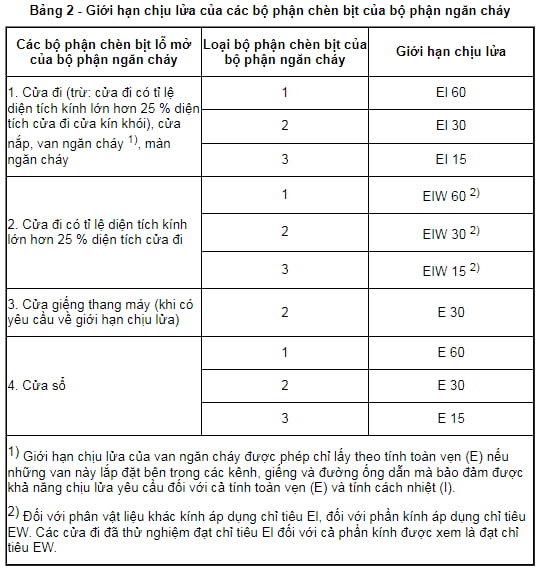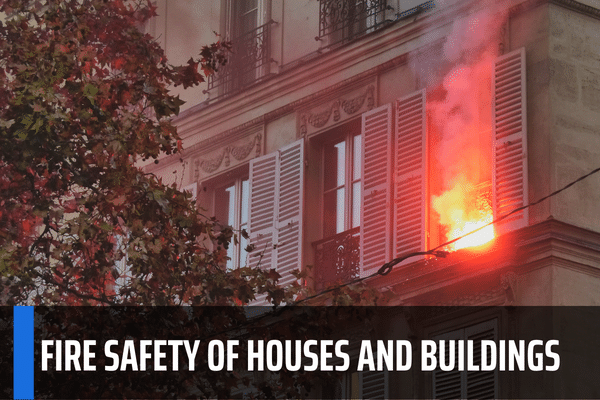How to classify the danger of materials to ensure fire safety of houses and buildings in Vietnam?
How to classify the danger of materials to ensure fire safety of houses and buildings in Vietnam?
Pursuant to subsection 2.1, Section 2 of the Regulation promulgated together with Circular 06/2022/TT-BXD guiding the classification of hazards of materials to ensure fire safety in the construction of houses and works as follows:
The fire hazard of building materials is determined according to the technical characteristics of fire:
- Combustibility
- Flammability;
- Spread of fire on the surface;
- Possibility of smoke generation;
- Toxicity.
Inside:
Classification according to flammability:
According to flammability, construction materials are classified into non-combustible materials and combustible materials. Combustible building materials are classified into 4 groups:
- Ch1 (weak fire);
- Ch2 (moderate fire);
- Ch3 (medium strong fire);
- Ch4 (strong fire).
Grouping according to flammability:
According to flammability, burning building materials are classified into 3 groups:
- BC1 (difficult to ignite);
- BC2 (moderately flammable);
- BC3 (flammable).
Grouping according to fire spread:
According to the spread of fire on the surface, burning building materials are classified into 4 groups
- LT1 (Non-propagating);
- LT2 (weakly spread);
- LT3 (moderately spread);
- LT4 (strongly spread).
Grouping according to smoke generation:
According to the ability to generate smoke, burning building materials are classified into 3 groups:
- SK1 (low smoke generation);
- SK2 (moderate smoke generation);
- SK3 (high smoke generation).
Classification according to toxicity:
According to the toxicity of combustion products, burning building materials are classified into 4 groups:
- DT1 (low toxicity);
- DT2 (moderate toxicity);
- DT3 (high toxicity);
- DT4 (especially high toxicity).

Vietnam National Technical regulations QCVN 06:2022/BXD: How to classify the danger of materials to ensure fire safety of houses and buildings in Vietnam?
How to classify fire stopping to ensure fire safety of houses and buildings in Vietnam?
According to the provisions of subsection 2.3, Section 2 of the Regulation promulgated together with Circular 06/2022/TT-BXD guiding the classification of fire stopping to ensure fire safety when building houses as follows:
Accordingly, fire stopping is classified according to measures to prevent the spread of fire-dangerous elements, as well as according to fire stopping to select construction structures and parts that seal the openings of fire stopping with required fire resistance limit and fire hazard grade.
Specifically:
- Fire stopping, including fire-stopping walls, fire-stopping partitions and fire-stopping floors, are classified into categories as shown in Table 1.

Note: In addition to the above fire stopping, to prevent the spread of fire, there are also measures to use: fire curtain, fire stopping water curtain, fire prevention distance, and space without fire load.
- Parts that seal the opening of the fire stop (fire door, lid, fire prevention valve, window, fire curtain) depending on the fire resistance limit of their partition are classified into types as Table 2.

Note: The fire resistance limit of fire prevention valves of air distribution systems is determined according to ISO 10294 or equivalent standards. The fire resistance limit of doors, windows and doors is determined according to Vietnamese National Standard TCVN 9383 or equivalent standards.
- The fire-stopping buffer compartments arranged in the opening of the fire-stopping part depend on the type of components that make up the fire-stopping space, and are classified into type 1 and type 2 fire-stopping buffer compartments.
What are the criteria to classify the fire safety of houses and buildings in Vietnam?
Pursuant to subsection 2.5, Section 2 of the Regulation promulgated together with Circular 06/2022/TT-BXD guiding the classification of houses and works to ensure fire safety as follows:
The technical classification of fire for houses, constructions and fire compartments currently includes the following criteria:
- Fire resistance grade;
- Structural fire hazard class;
- Fire hazard group according to function.
Specifically, the classification of houses and works to ensure fire safety is regulated as follows:
- Buildings, constructions and fire compartments are classified into 5 fire resistance grades I, II, III, IV, V.
- The fire resistance level of a building, construction, or fire compartment is established depending on the number of floors (or the height of the fire prevention and fighting system of the building), the fire hazard group by function, the area of the fire compartment (see Appendix H) and the danger of fire. Fire hazards of technological processes take place in buildings, buildings, and fire compartments.
- The required fire resistance limit of the building structure must be selected in accordance with the selected fire resistance level of the building, building and fire compartment. Except for the cases specified in this regulation, the conformity between the fire resistance level of the building, building and fire compartment with the fire resistance limit of their construction structure is specified in Table 4.

Note:
- In buildings with fire resistance levels I, II, III, the floor and ceiling of the basement and semi-basement must be made of non-combustible materials and have a fire resistance limit of at least REI 90. The floor of the first and top floors must be made of non-combustible materials. made of materials with flammability not lower than Ch1. In buildings with fire resistance levels IV and V, the floor of the basement or semi-basement must be made of materials with flammability not lower than Ch1 and with a fire resistance limit of not less than REl 45.
- The fire resistance limit of roofing sheets (including roofing sheets with insulation) and purlins supporting the roofing sheets is not specified (except for buildings, fire compartments, rooms belonging to the fire hazard group according to function F3.1, F3.2, manufacturers, warehouses of group F5 and other buildings, rooms and fire compartments of classes A, B, C) when the following conditions are simultaneously satisfied:
+ The underside of wooden beams is located at least 6.1 m from the floor directly below them,
+ Roofing sheets and purlins are made from non-combustible or weakly combustible materials (Ch1).
- For houses (houses of group F1.3 and mixed houses) with 2 or 3 basements, the load-bearing structural members in the basement must have a minimum fire resistance limit of R 120.
- In rooms where flammable liquids are produced or stored, the distribution floor is made of non-combustible materials.
- Allowing a part of non-load-bearing outer wall without fire protection with a defined area According to E.3, Annex E.
- The fire resistance limit of non-load-bearing outer wall is not specified for the building's facades and satisfy the following conditions:
+ The whole building is equipped with automatic fire sprinkler according to Vietnamese National Standard TCVN 7336;
+ Ensure the minimum fire prevention distance corresponding to 100% of the area of the outer wall that does not need fire protection at E.3, Appendix E;
+ Non-load-bearing outer walls of buildings with fire danger grade K0. Exterior wall finishing materials (if any) are non-combustible materials or have flammability not lower than Ch1 and fire spreadability not lower than LT1.
LawNet
